instrument panel Hyundai Equus 2016 Owner's Manual
[x] Cancel search | Manufacturer: HYUNDAI, Model Year: 2016, Model line: Equus, Model: Hyundai Equus 2016Pages: 477, PDF Size: 16.25 MB
Page 14 of 477
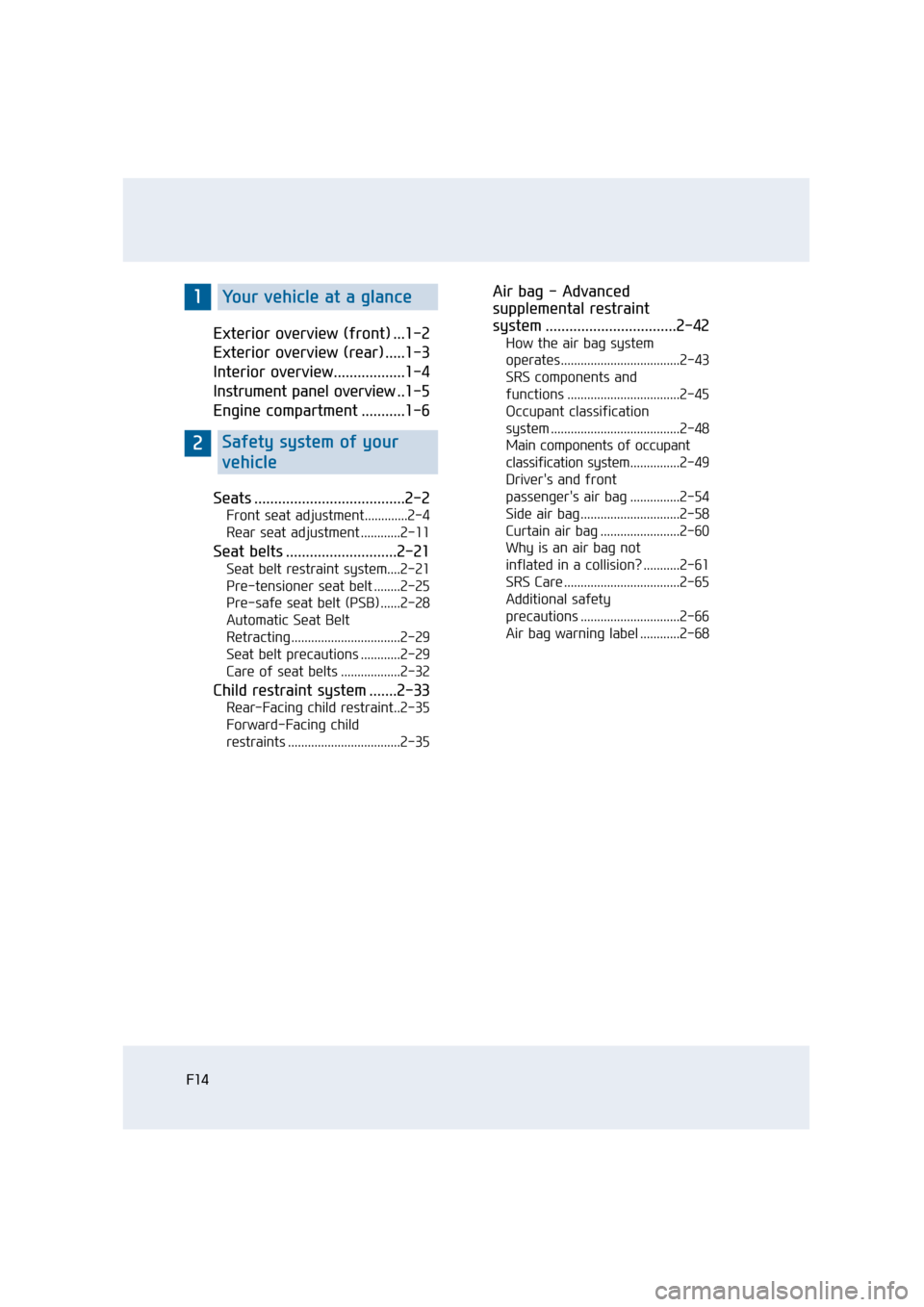
F14
Exterior overview (front) ...1-2
Exterior overview (rear) .....1-3
Interior overview..................1-4
Instrument panel overview ..1-5
Engine compartment ...........1-6
Seats ......................................2-2
Front seat adjustment.............2-4
Rear seat adjustment ............2-11
Seat belts ............................2-21
Seat belt restraint system....2-21
Pre-tensioner seat belt ........2-25
Pre-safe seat belt (PSB) ......2-28
Automatic Seat Belt
Retracting .................................2-29
Seat belt precautions ............2-29
Care of seat belts ..................2-32
Child restraint system .......2-33
Rear-Facing child restraint..2-35
Forward-Facing child
restraints ..................................2-35
Air bag - Advanced
supplemental restraint
system .................................2-42
How the air bag system
operates....................................2-43
SRS components and
functions ..................................2-45
Occupant classification
system .......................................2-48
Main components of occupant
classification system ...............2-49
Driver's and front
passenger's air bag ...............2-54
Side air bag ..............................2-58
Curtain air bag ........................2-60
Why is an air bag not
inflated in a collision? ...........2-61
SRS Care ...................................2-65
Additional safety
precautions ..............................2-66
Air bag warning label ............2-68
1Your vehicle at a glance
2Safety system of your
vehicle
Page 22 of 477
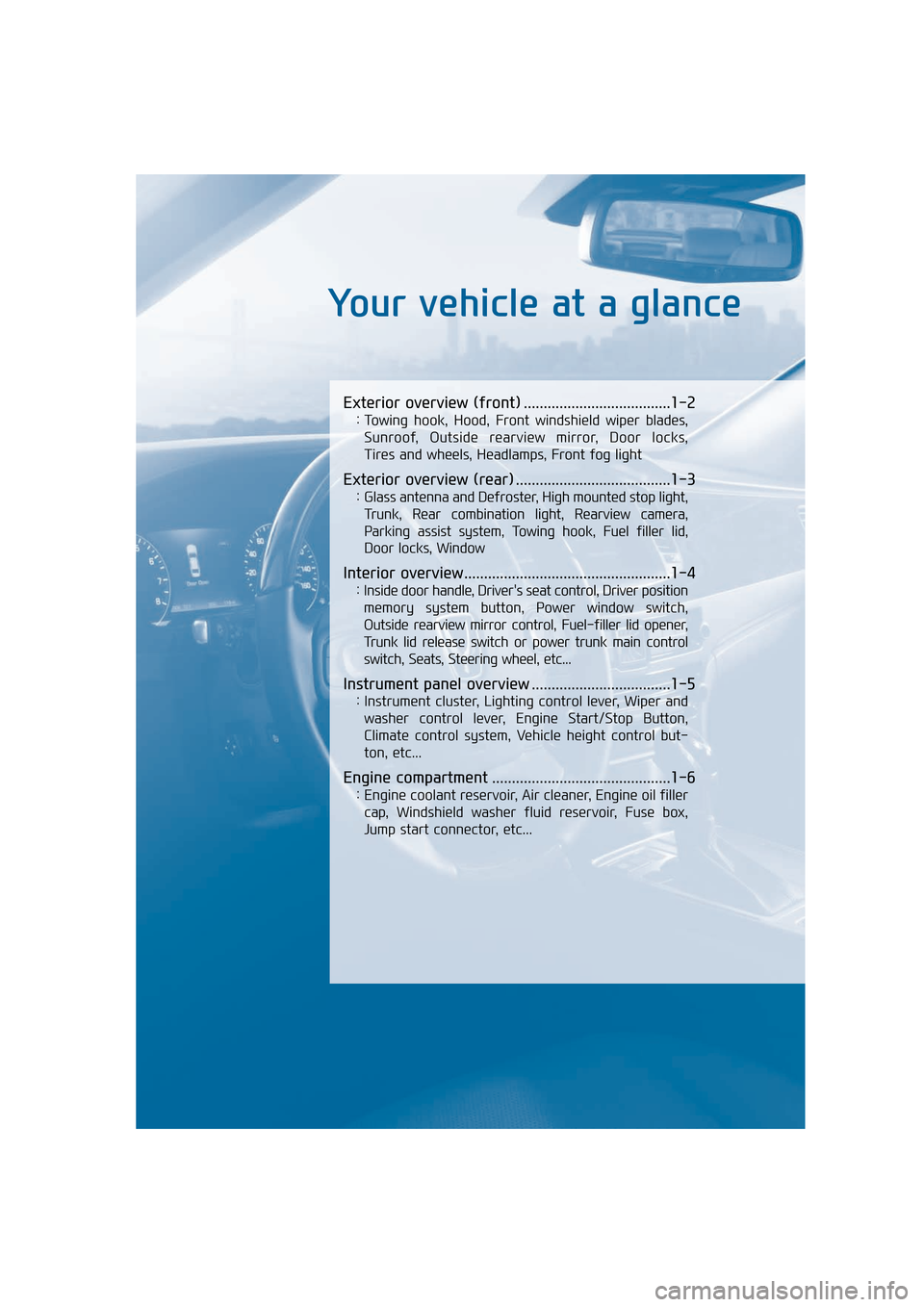
Your vehicle at a glance
Exterior overview (front) .....................................1-2
: Towing hook, Hood, Front windshield wiper blades, Sunroof, Outside rearview mirror, Door locks,
Tires and wheels, Headlamps, Front fog light
Exterior overview (rear) .......................................1-3
: Glass antenna and Defroster, High mounted stop light, Trunk, Rear combination light, Rearview camera,
Parking assist system, Towing hook, Fuel filler lid,
Door locks, Window
Interior overview ....................................................1-4
: Inside door handle, Driver's seat control, Driver position memory system button, Power window switch,
Outside rearview mirror control, Fuel-filler lid opener,
Trunk lid release switch or power trunk main control
switch, Seats, Steering wheel, etc...
Instrument panel overview ...................................1-5
: Instrument cluster, Lighting control lever, Wiper and washer control lever, Engine Start/Stop Button,
Climate control system, Vehicle height control but-
ton, etc...
Engine compartment .............................................1-6
: Engine coolant reservoir, Air cleaner, Engine oil fillercap, Windshield washer fluid reservoir, Fuse box,
Jump start connector, etc...
Page 25 of 477

1. Inside door handle..................................3-15
2. Driver’s seat control ..................................2-5
3. Driver position memory system button ..3-40
4. Power window switch .............................3-28
5. Outside rearview mirror control..............3-58
6. Fuel-filler lid opener ................................3-34
7. BSD (Blind spot detection) on/off button ..5-58
8. Parking assist system on/off button .....3-102
9. Instrument panel illumination control button ..........................................3-64
10. HUD (Head up display) on/off button...3-100 11. ESC (Electronic stability control)
off button...............................................5-28
12. Trunk lid release switch or power trunk main control switch ..3-18/3-19
13. EPB (Electric parking brake) switch.....5-19
14. Brake pedal ..........................................5-17
15. Hood release lever ...............................3-33
16. Seats.......................................................2-2
17. Tilt/Telescope steering control lever .....3-42
18. Heated steering wheel on/off button ......3-43
19. Steering wheel......................................3-42
I I N
N T
TE
ER
R I
IO
O R
R
O
O V
VE
ER
R V
V I
IE
E W
W
1-4
Your vehicle at a glance
OVI015003N
■Type A
■Type B
❈ The actual shape may differ from the illustration.
Page 31 of 477
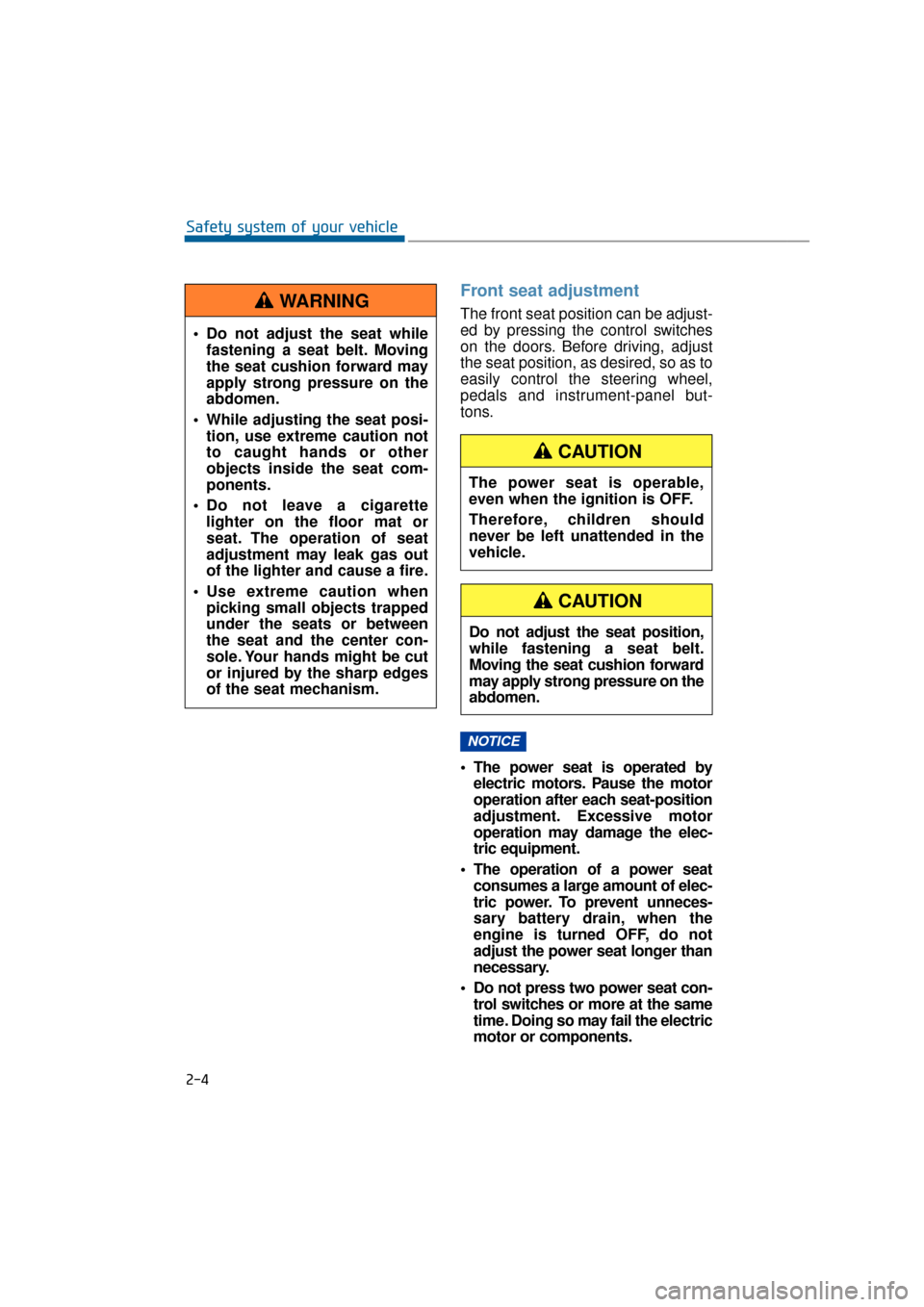
Front seat adjustment
The front seat position can be adjust-
ed by pressing the control switches
on the doors. Before driving, adjust
the seat position, as desired, so as to
easily control the steering wheel,
pedals and instrument-panel but-
tons.
The power seat is operated byelectric motors. Pause the motor
operation after each seat-position
adjustment. Excessive motor
operation may damage the elec-
tric equipment.
The operation of a power seat consumes a large amount of elec-
tric power. To prevent unneces-
sary battery drain, when the
engine is turned OFF, do not
adjust the power seat longer than
necessary.
Do not press two power seat con- trol switches or more at the same
time. Doing so may fail the electric
motor or components.
NOTICE
2-4
Safety system of your vehicle
Do not adjust the seat while fastening a seat belt. Moving
the seat cushion forward may
apply strong pressure on the
abdomen.
While adjusting the seat posi- tion, use extreme caution not
to caught hands or other
objects inside the seat com-
ponents.
Do not leave a cigarette lighter on the floor mat or
seat. The operation of seat
adjustment may leak gas out
of the lighter and cause a fire.
Use extreme caution when picking small objects trapped
under the seats or between
the seat and the center con-
sole. Your hands might be cut
or injured by the sharp edges
of the seat mechanism.
WARNING
Do not adjust the seat position,
while fastening a seat belt.
Moving the seat cushion forward
may apply strong pressure on the
abdomen.
CAUTION
The power seat is operable,
even when the ignition is OFF.
Therefore, children should
never be left unattended in the
vehicle.
CAUTION
Page 71 of 477
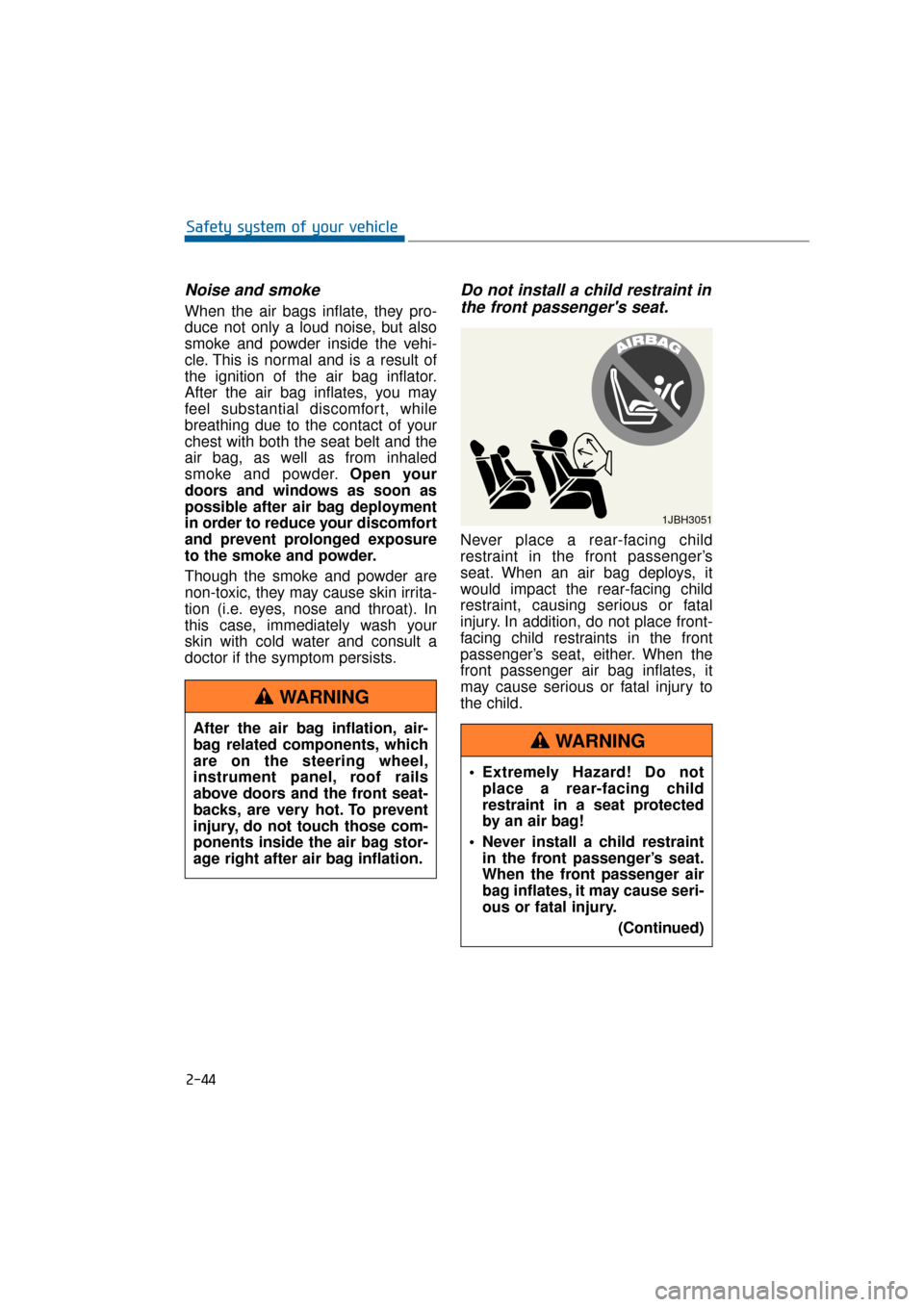
Noise and smoke
When the air bags inflate, they pro-
duce not only a loud noise, but also
smoke and powder inside the vehi-
cle. This is normal and is a result of
the ignition of the air bag inflator.
After the air bag inflates, you may
feel substantial discomfort, while
breathing due to the contact of your
chest with both the seat belt and the
air bag, as well as from inhaled
smoke and powder.Open your
doors and windows as soon as
possible after air bag deployment
in order to reduce your discomfort
and prevent prolonged exposure
to the smoke and powder.
Though the smoke and powder are
non-toxic, they may cause skin irrita-
tion (i.e. eyes, nose and throat). In
this case, immediately wash your
skin with cold water and consult a
doctor if the symptom persists.
Do not install a child restraint in the front passenger's seat.
Never place a rear-facing child
restraint in the front passenger’s
seat. When an air bag deploys, it
would impact the rear-facing child
restraint, causing serious or fatal
injury. In addition, do not place front-
facing child restraints in the front
passenger’s seat, either. When the
front passenger air bag inflates, it
may cause serious or fatal injury to
the child.
2-44
Safety system of your vehicle
After the air bag inflation, air-
bag related components, which
are on the steering wheel,
instrument panel, roof rails
above doors and the front seat-
backs, are very hot. To prevent
injury, do not touch those com-
ponents inside the air bag stor-
age right after air bag inflation.
WARNING
1JBH3051
Extremely Hazard! Do not place a rear-facing child
restraint in a seat protected
by an air bag!
Never install a child restraint in the front passenger’s seat.
When the front passenger air
bag inflates, it may cause seri-
ous or fatal injury.
(Continued)
WARNING
Page 73 of 477
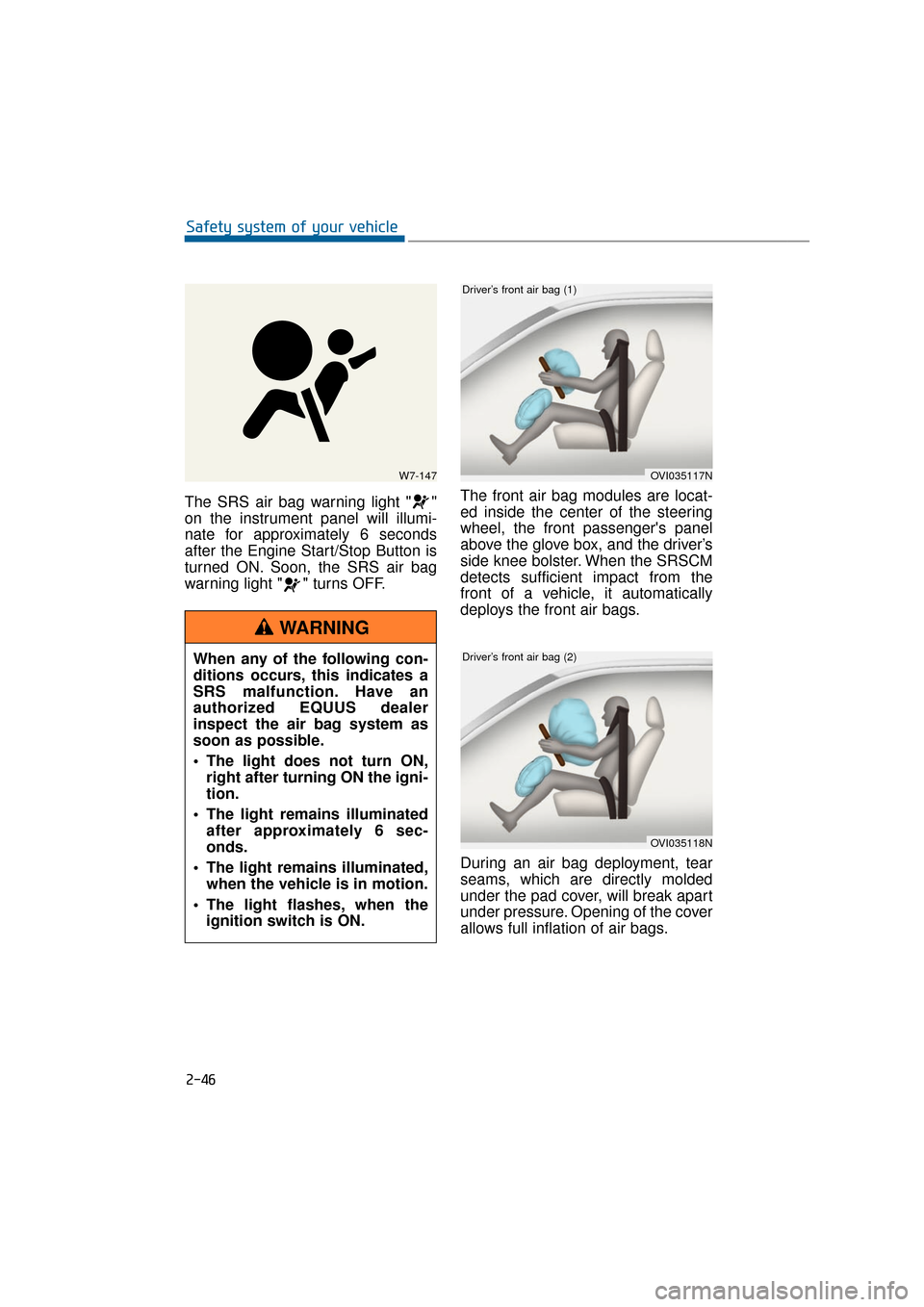
The SRS air bag warning light " "
on the instrument panel will illumi-
nate for approximately 6 seconds
after the Engine Start/Stop Button is
turned ON. Soon, the SRS air bag
warning light " " turns OFF.The front air bag modules are locat-
ed inside the center of the steering
wheel, the front passenger's panel
above the glove box, and the driver’s
side knee bolster. When the SRSCM
detects sufficient impact from the
front of a vehicle, it automatically
deploys the front air bags.
During an air bag deployment, tear
seams, which are directly molded
under the pad cover, will break apart
under pressure. Opening of the cover
allows full inflation of air bags.
2-46
Safety system of your vehicle
W7-147
When any of the following con-
ditions occurs, this indicates a
SRS malfunction. Have an
authorized EQUUS dealer
inspect the air bag system as
soon as possible.
The light does not turn ON,
right after turning ON the igni-
tion.
The light remains illuminated after approximately 6 sec-
onds.
The light remains illuminated, when the vehicle is in motion.
The light flashes, when the ignition switch is ON.
WARNING
OVI035117N
Driver’s front air bag (1)
OVI035118N
Driver’s front air bag (2)
Page 74 of 477
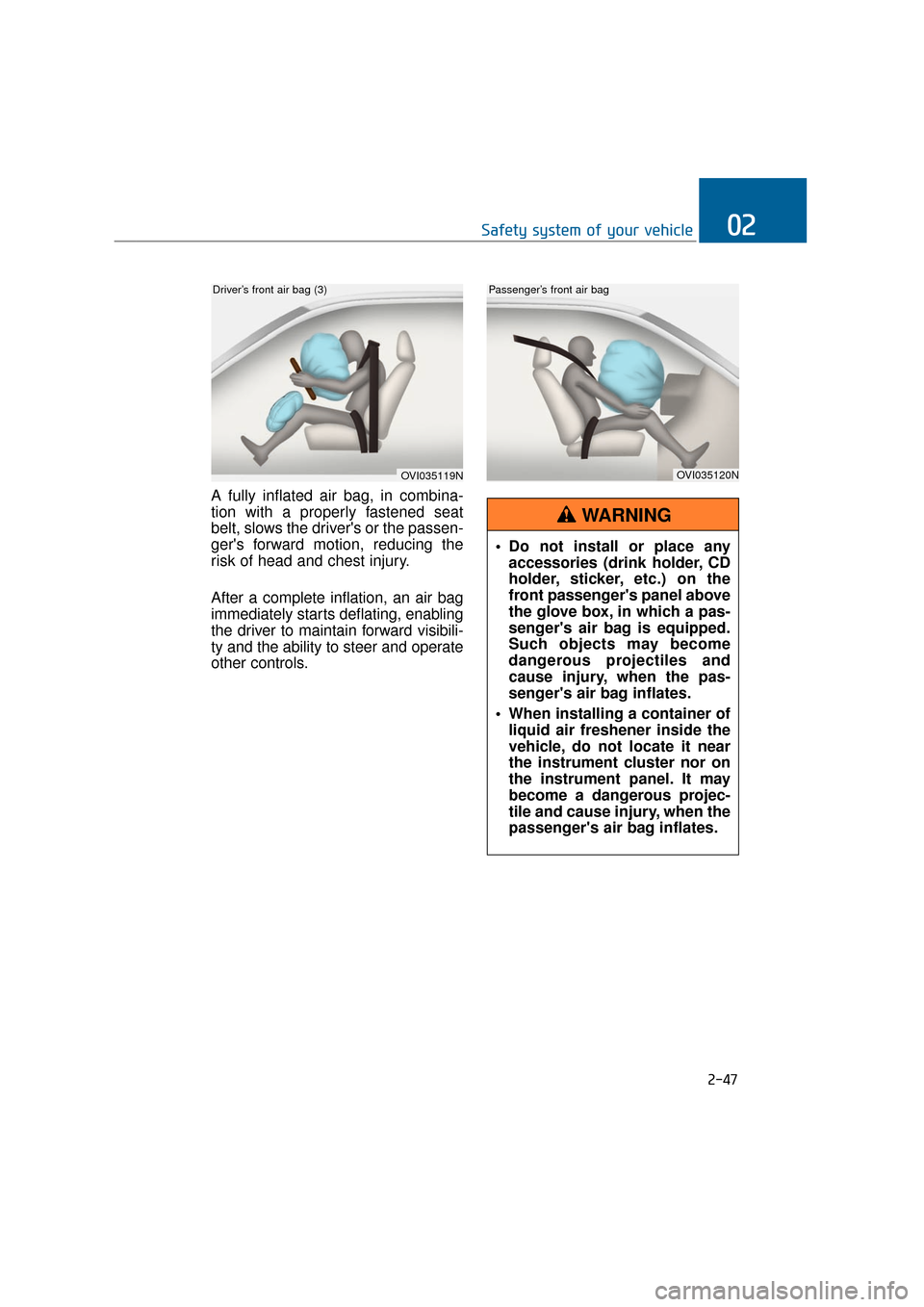
A fully inflated air bag, in combina-
tion with a properly fastened seat
belt, slows the driver's or the passen-
ger's forward motion, reducing the
risk of head and chest injury.
After a complete inflation, an air bag
immediately starts deflating, enabling
the driver to maintain forward visibili-
ty and the ability to steer and operate
other controls.
2-47
Safety system of your vehicle02
OVI035119N
Driver’s front air bag (3)
OVI035120N
Passenger’s front air bag
Do not install or place anyaccessories (drink holder, CD
holder, sticker, etc.) on the
front passenger's panel above
the glove box, in which a pas-
senger's air bag is equipped.
Such objects may become
dangerous projectiles and
cause injury, when the pas-
senger's air bag inflates.
When installing a container of liquid air freshener inside the
vehicle, do not locate it near
the instrument cluster nor on
the instrument panel. It may
become a dangerous projec-
tile and cause injury, when the
passenger's air bag inflates.
WARNING
Page 76 of 477
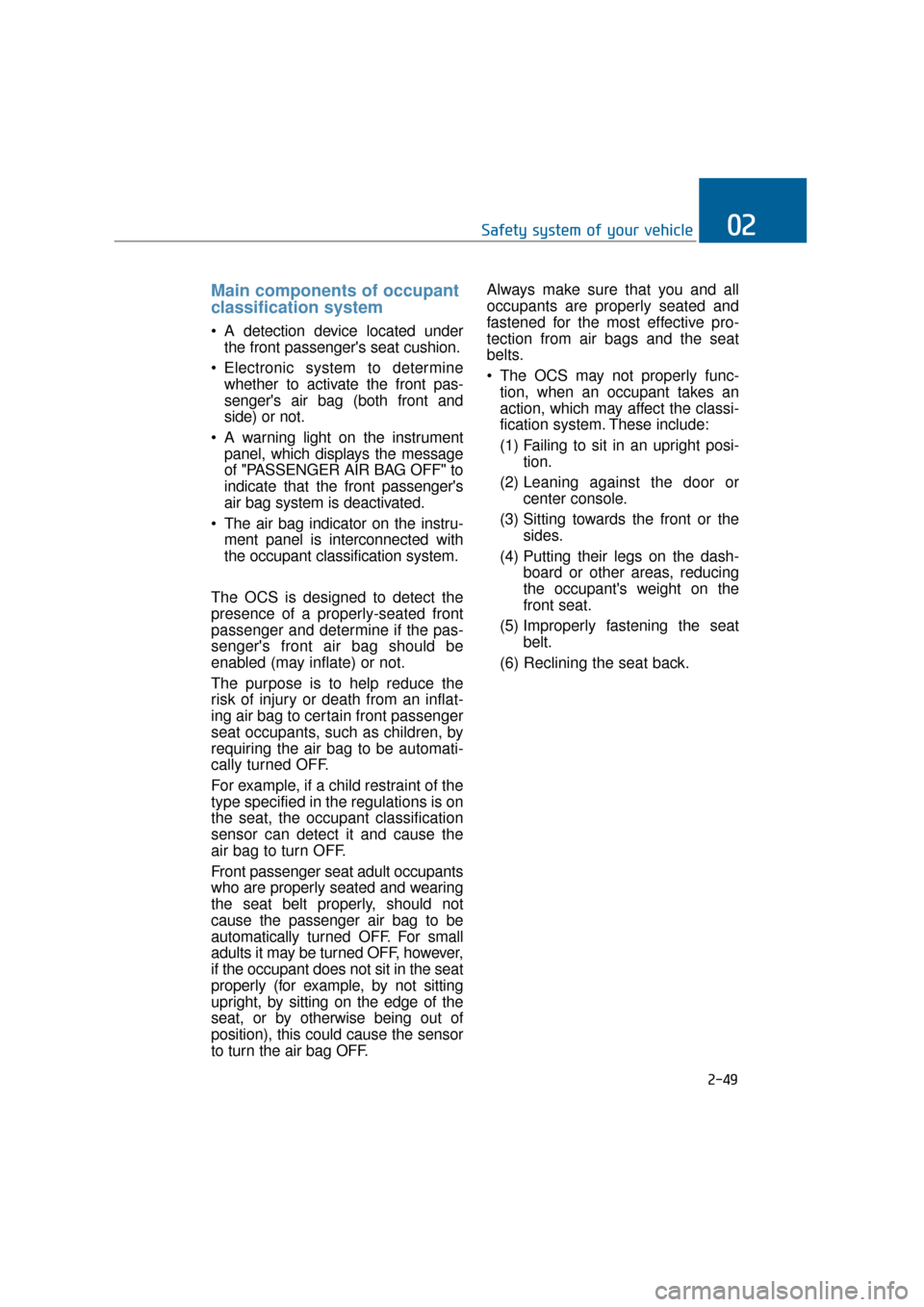
Main components of occupant
classification system
A detection device located underthe front passenger's seat cushion.
Electronic system to determine whether to activate the front pas-
senger's air bag (both front and
side) or not.
A warning light on the instrument panel, which displays the message
of "PASSENGER AIR BAG OFF" to
indicate that the front passenger's
air bag system is deactivated.
The air bag indicator on the instru- ment panel is interconnected with
the occupant classification system.
The OCS is designed to detect the
presence of a properly-seated front
passenger and determine if the pas-
senger's front air bag should be
enabled (may inflate) or not.
The purpose is to help reduce the
risk of injury or death from an inflat-
ing air bag to certain front passenger
seat occupants, such as children, by
requiring the air bag to be automati-
cally turned OFF.
For example, if a child restraint of the
type specified in the regulations is on
the seat, the occupant classification
sensor can detect it and cause the
air bag to turn OFF.
Front passenger seat adult occupants
who are properly seated and wearing
the seat belt properly, should not
cause the passenger air bag to be
automatically turned OFF. For small
adults it may be turned OFF, however,
if the occupant does not sit in the seat
properly (for example, by not sitting
upright, by sitting on the edge of the
seat, or by otherwise being out of
position), this could cause the sensor
to turn the air bag OFF. Always make sure that you and all
occupants are properly seated and
fastened for the most effective pro-
tection from air bags and the seat
belts.
The OCS may not properly func-
tion, when an occupant takes an
action, which may affect the classi-
fication system. These include:
(1) Failing to sit in an upright posi- tion.
(2) Leaning against the door or
center console.
(3) Sitting towards the front or the sides.
(4) Putting their legs on the dash- board or other areas, reducing
the occupant's weight on the
front seat.
(5) Improperly fastening the seat belt.
(6) Reclining the seat back.
2-49
Safety system of your vehicle02
Page 81 of 477
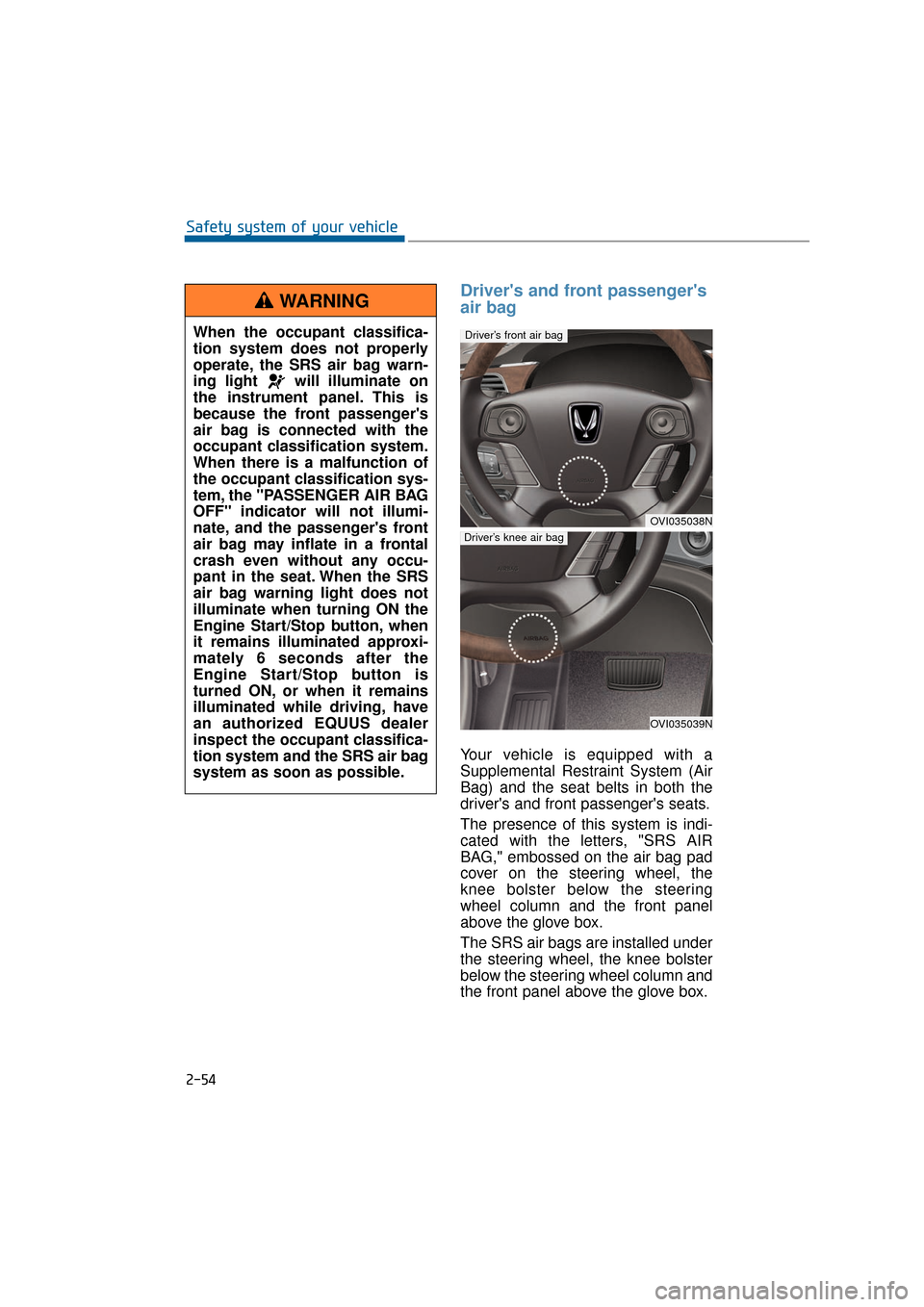
Driver's and front passenger's
air bag
Your vehicle is equipped with a
Supplemental Restraint System (Air
Bag) and the seat belts in both the
driver's and front passenger's seats.
The presence of this system is indi-
cated with the letters, "SRS AIR
BAG," embossed on the air bag pad
cover on the steering wheel, the
knee bolster below the steering
wheel column and the front panel
above the glove box.
The SRS air bags are installed under
the steering wheel, the knee bolster
below the steering wheel column and
the front panel above the glove box.
2-54
Safety system of your vehicleWhen the occupant classifica-
tion system does not properly
operate, the SRS air bag warn-
ing light will illuminate on
the instrument panel. This is
because the front passenger's
air bag is connected with the
occupant classification system.
When there is a malfunction of
the occupant classification sys-
tem, the "PASSENGER AIR BAG
OFF" indicator will not illumi-
nate, and the passenger's front
air bag may inflate in a frontal
crash even without any occu-
pant in the seat. When the SRS
air bag warning light does not
illuminate when turning ON the
Engine Start/Stop button, when
it remains illuminated approxi-
mately 6 seconds after the
Engine Start/Stop button is
turned ON, or when it remains
illuminated while driving, have
an authorized EQUUS dealer
inspect the occupant classifica-
tion system and the SRS air bag
system as soon as possible.
WARNING
OVI035038N
Driver’s front air bag
OVI035039N
Driver’s knee air bag
Page 82 of 477
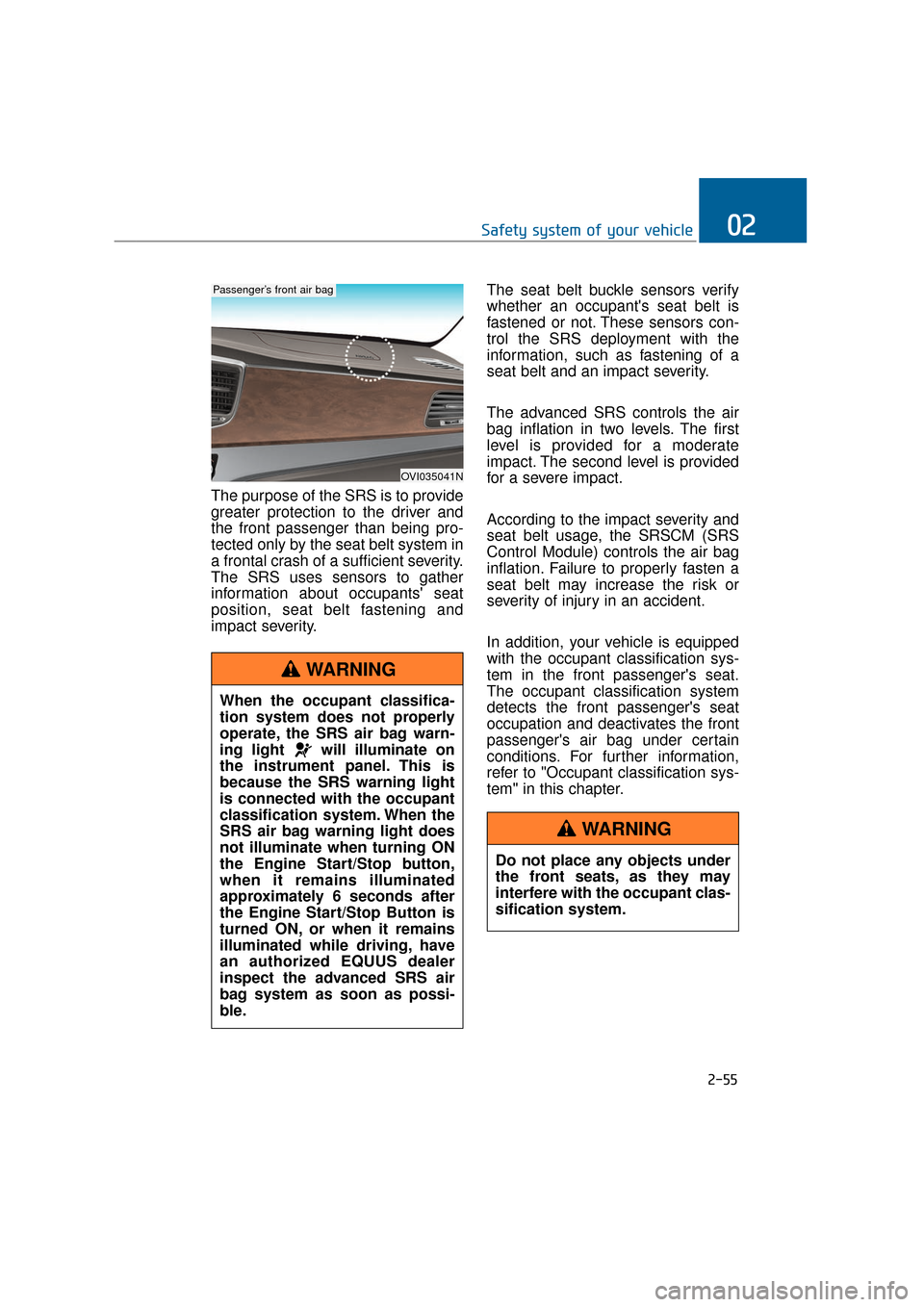
The purpose of the SRS is to provide
greater protection to the driver and
the front passenger than being pro-
tected only by the seat belt system in
a frontal crash of a sufficient severity.
The SRS uses sensors to gather
information about occupants' seat
position, seat belt fastening and
impact severity.The seat belt buckle sensors verify
whether an occupant's seat belt is
fastened or not. These sensors con-
trol the SRS deployment with the
information, such as fastening of a
seat belt and an impact severity.
The advanced SRS controls the air
bag inflation in two levels. The first
level is provided for a moderate
impact. The second level is provided
for a severe impact.
According to the impact severity and
seat belt usage, the SRSCM (SRS
Control Module) controls the air bag
inflation. Failure to properly fasten a
seat belt may increase the risk or
severity of injury in an accident.
In addition, your vehicle is equipped
with the occupant classification sys-
tem in the front passenger's seat.
The occupant classification system
detects the front passenger's seat
occupation and deactivates the front
passenger's air bag under certain
conditions. For further information,
refer to "Occupant classification sys-
tem" in this chapter.
2-55
Safety system of your vehicle02
OVI035041N
Passenger’s front air bag
When the occupant classifica-
tion system does not properly
operate, the SRS air bag warn-
ing light will illuminate on
the instrument panel. This is
because the SRS warning light
is connected with the occupant
classification system. When the
SRS air bag warning light does
not illuminate when turning ON
the Engine Start/Stop button,
when it remains illuminated
approximately 6 seconds after
the Engine Start/Stop Button is
turned ON, or when it remains
illuminated while driving, have
an authorized EQUUS dealer
inspect the advanced SRS air
bag system as soon as possi-
ble.
WARNING
Do not place any objects under
the front seats, as they may
interfere with the occupant clas-
sification system.
WARNING